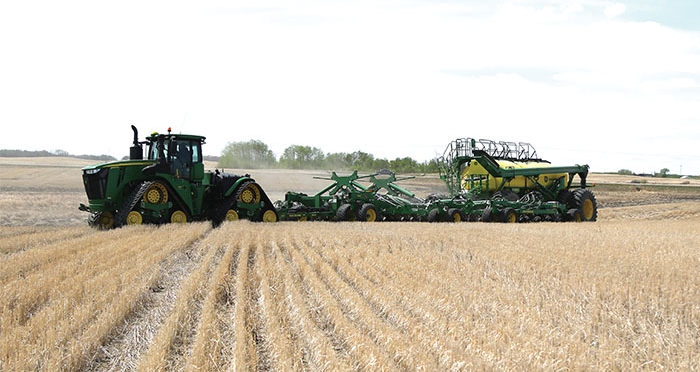Most of the 2018 crop in the ground
May 29, 2018, 1:42 am
Kara Kinna


Farmers have most of the 2018 crop in the ground. Many farmers in the local area were wrapping up seeding last week, and were happy to see some much-needed rain for their crops and pasture land.
According to the provincial crop report, as of last Monday 70 per cent of the crop is now in the ground, up from 35 per cent the previous week and well ahead of the five-year (2013-2017) seeding average of 55 per cent for this time of year.
The southeast region is the most advanced with 82 per cent of the crop seeded as of Monday last week. Seventy-seven per cent is seeded in the northeast, 72 per cent in the southwest, 66 in the west-central region, 65 per cent in the northwest and 53 per cent in the east-central region.
Rainfall was reported in some areas, ranging from trace amounts to 28 mm in the Biggar area.
John Van Eaton, who farms at Maryfield, said he only had a few days of seeding left last week, but he was still happy to see the rain.
“We have a few days left but the rain is more than welcome,” he said.
“Our field crops were still in pretty good shape. We had lots of subsoil moisture for germination, we haven’t worked our fields as much as some, but certainly our pastures and hay fields were in dire need of a rain.”
Van Eaton says showers in the area were spotty last week, but he received about three-quarters of an inch on his farmland.
Van Eaton planted spring wheat, canola, a couple of varieties of barley, and some forage crops. He says he for the first time in a long time he didn’t put in peas.
“For the first year in about 30 years we’re not growing any peas. The tarif and then the import duty that India has put on has really affected the international market. That was one of the factors,” he says. “There were a number of factors but certainly the price was one of them.”
Seeding is finished on the Jaenens’ farmland between Moosomin and Fairlight, where wheat, oats, barley and canola were planted this year, but Nancy Jaenen says they were getting worried about the dry weather until some showers showed up last week.
“We were getting very worried because we have cattle too, and of course the pastures were starting to look pretty scary. The rain was very welcome,” she says.
“They were worried about the canola coming up, but it should be good now.”
Jaenen says more rain is still needed.
“I think everybody would agree that we really need more rain,” she says. “This was welcome, but we need more. We don’t want downpours, just a nice steady rain.”
Dry weather aside, harvest went well for the Jaenens this year. “Everything went well, we had good help,” says Nancy. “We didn’t have any holdups with being stopped by wet, we were able to sow through everything because everything was dry.”
Murray Reid, who farms between Welwyn and Rocanville, says seeding conditions were perfect this year in his area, but the pastures are in dire need of more moisture. Reid planted wheat and canola this year.
“We’re going to need a rain now,” he said Thursday, before the area received some rain on Thursday evening. “But it was almost perfect seeding conditions with moisture and the sloughs dried up so we can go through all the low spots. I never got stuck once.
“It’s the pastures that need the rain worse than anything. The pastures are concerning for most guys. It’s been kind of a late, cool spring, and grass always needs a good rain to get it going. And the hay doesn’t add up to much if doesn’t rain.”
Reid says if he could order any weather he wanted, he’d order a two-inch rain.
“That’s what I would order, but you just take what you can get,” he says.
The majority of the province remains in need of rain to replenish the topsoil moisture as warm temperatures and strong winds continue to dry fields. Provincially, topsoil moisture conditions on crop land are rated as 47 per cent adequate, 39 per cent short and 14 per cent very short. Hay land and pasture topsoil moisture is rated as 31 per cent adequate, 46 per cent short and 23 per cent very short.
Crops are slowly emerging but are mostly in good condition despite damage from strong winds and lack of moisture. The majority are either at or behind normal developmental stages for this time of year.
Pastures and hay land remain dry and growth has been slow. Pasture conditions are rated as 22 per cent good, 40 per cent fair, 28 per cent poor and 10 per cent very poor.
SaskPower reports 34 cases of farm machinery contacting electrical equipment in the last week, bringing the total in May to 119. SaskPower reminds producers that most farm-related incidents happen during the spring. Please check for overhead power lines and plan ahead when moving equipment.



































